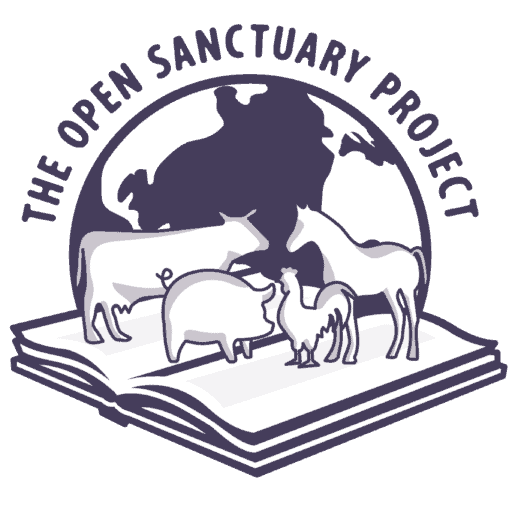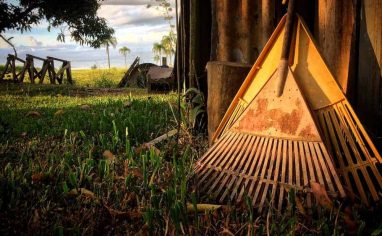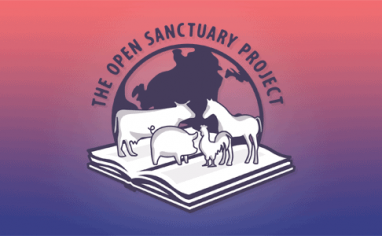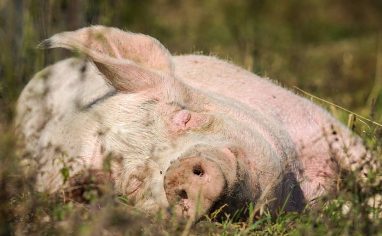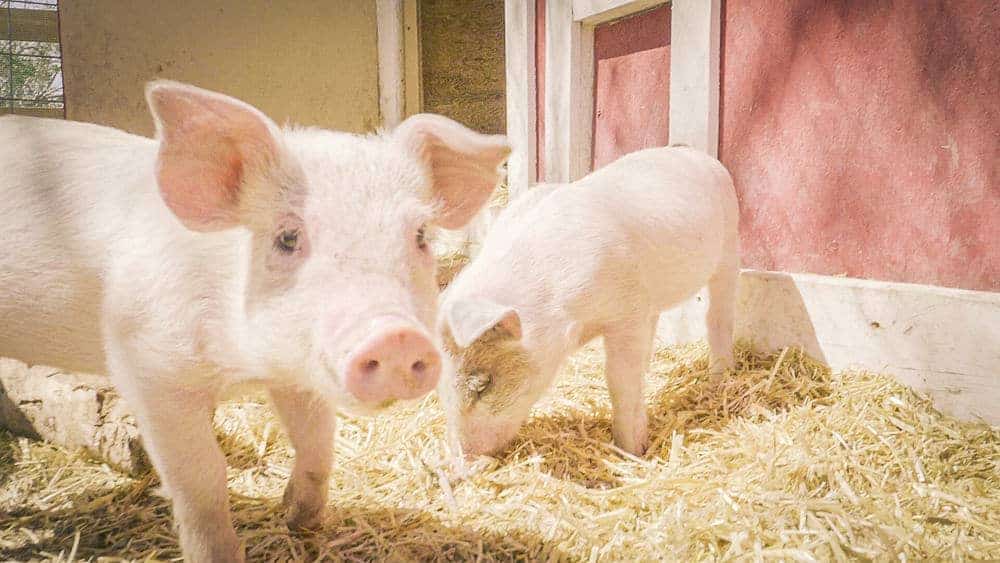
This resource was fully reviewed and updatedA member of The Open Sanctuary Project’s staff has given this resource a full review and provided updates where necessary. by a staff member of The Open Sanctuary Project as of October 17, 2024. It was originally published on August 18, 2018.
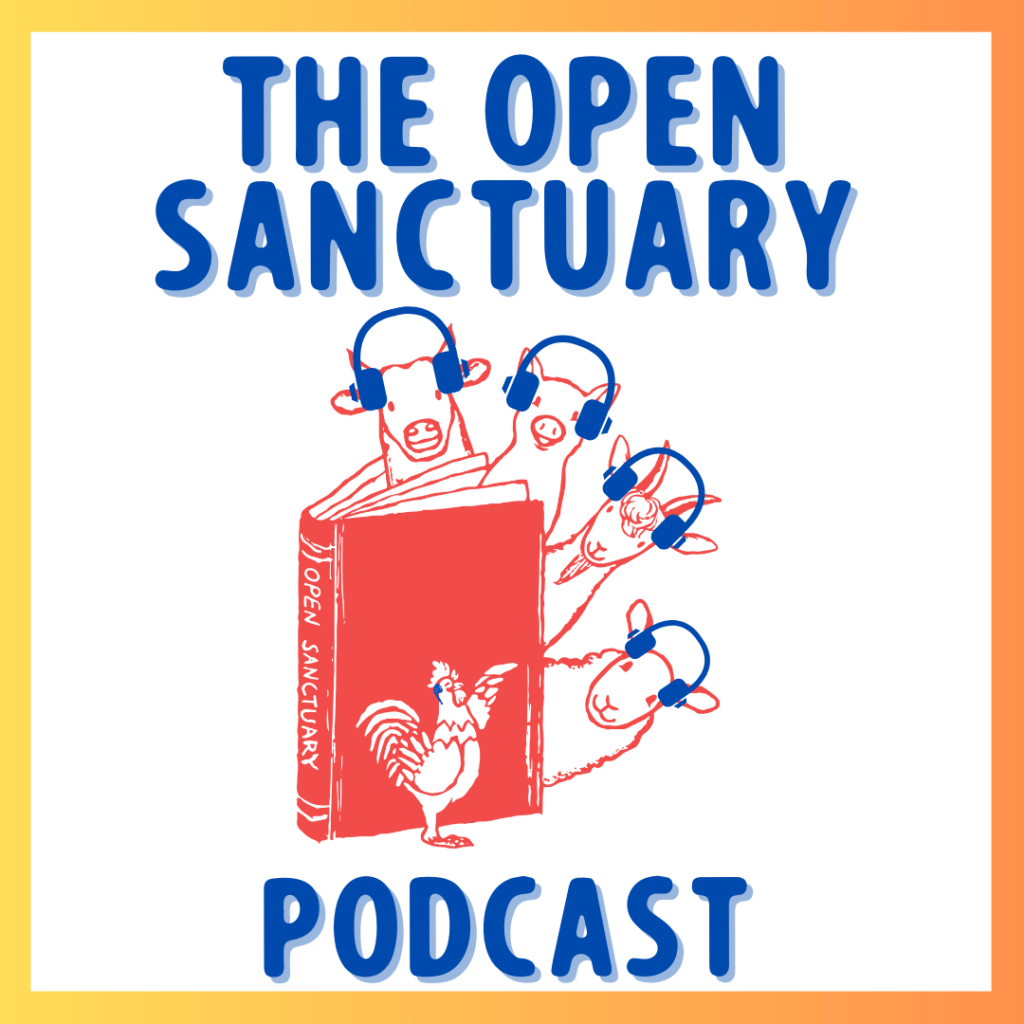
We Have A Podcast Episode On This Subject!
Want to learn about this topic in a different format? Check out our episode of The Open Sanctuary Podcast about adoption policy considerations for sanctuaries here!
If you’re operating a farmed animal sanctuaryAn animal sanctuary that primarily cares for rescued animals that were farmed by humans., it’s important to decide whether your organization will implement an adoption program for your residents or potential rescues. Your decision should be carefully considered, taking stock of your sanctuary’s Philosophy of Care and available resources. Many sanctuaries have had success with carefully crafted adoption programs, and many others have decided not to offer adoption services after thoughtful consideration.
The Case For An Adoption Program
Resources are always going to be limited at even the most well-managed farmed animal sanctuaries, be it a limitation of funding, acreage, facilities, or personnel. The need for caring and qualified farmed animal guardians and advocates is simply too high to possibly take care of every abused or neglected animal in the world currently. As a result, well-organized adoption programs can help create more space in sanctuary environments for potential residents, especially residents with advanced care needs who might be better suited to live with caregivers who have more time for one-on-one care. The residents’ new adopted forever homes can serve as places that don’t just care for them, but also advocate for them, potentially under the banner of a Microsanctuary if the adopting party chooses to use that designation. Ultimately, implementing an adoption program can potentially save more individual lives.
Some sanctuaries adopt out certain rescues who never become permanent residents of their sanctuary, choosing to utilize their resources to find a home for them and keep them safe while vetting new guardians. This allows these sanctuaries to take an active role in caring for more animals without having to be dedicated to their care for the entirety of their natural lives.
Elements Of A Successful Adoption Program
The most critical component of a successful adoption program comes down to effective vetting of prospective homes: a process which can and should require you getting to know the potential adopter, the proposed living spaceThe indoor or outdoor area where an animal resident lives, eats, and rests., and the standard of care that the adopter follows. This can require a significant investment of time and energy! Be wary of adopters who resist this process, or want the adoptee as quickly as possible. While it can be tempting to skip steps, particularly if you are in a situation where you have done a large rescue and need homes quickly, taking shortcuts can lead to less than desirable outcomes.
Most sanctuaries that adopt out will first require a rigorous application, including questions about the interested party’s background, affiliation with animal organizations, knowledge level of the species they’re interested in adopting, and detailed descriptions of the living space they’re planning on creating and qualified veterinary care access. Some sanctuaries will then schedule both in-person interviews as well as visits to the potential new forever home for their residents. Because many species become depressed or anxious if they live alone, sanctuaries might require that certain species be adopted with one or more friends or relatives.
Some sanctuaries are strict about which residents can be adopted, or choose the exact resident to be adopted for prospective guardians, while others let interested parties get to know residents on an individual basis before deciding who they’d like to care for.
Once it’s been decided that the adoption is appropriate, a sanctuary must decide whether to require an adoption fee, as well as filing the appropriate paperwork and deciding whether they are willing to transport the newly adopted resident. Most adopting sanctuaries have strict legal contracts that require that no exploitationExploitation is characterized by the abuse of a position of physical, psychological, emotional, social, or economic vulnerability to obtain agreement from someone (e.g., humans and nonhuman animals) or something (e.g, land and water) that is unable to reasonably refuse an offer or demand. It is also characterized by excessive self gain at the expense of something or someone else’s labor, well-being, and/or existence. or harm come to the adopted resident, and that the adoptee must care for the resident for the entirety of their natural life without ever selling or giving them away. Certain species might require government paperwork to legally transfer guardianship, depending on where the sanctuary and the adopting party are located. It’s important to check in with qualified legal counsel in your jurisdiction to have them review your adoption contract to make that its provisions follow the necessary legal requirements, are clear, and that they are enforceable.
For some sanctuaries, vetting may not end once you have generally agreed upon the adoption. Some sanctuaries insist upon delivering the residents to be adopted to the space themselves rather than having the adopter pick them up or meeting in a third location, as this offers the opportunity for qualified caregivers to take one more look at a prospective living space and either offer suggestions for improvement, take notes of things to follow up about, or postpone or cancel an adoption should they decide that any part of the living space or adoption scenario is too risky to allow a resident to leave their sight.
As a contingency, some sanctuaries may provide for the ability to do follow up visits in their contracts, and then schedule them to ensure the ongoing health and comfort of the adopted resident. Adoption contracts may also include a clause that the sanctuary can take back the resident if the adoptive guardian does not or cannot continue to properly care for their adopted friend. All residents who are adopted out should be additionally documented using a form for the sanctuary’s records.
The Location Of An Adopter Can Impact The Monitoring And Enforcement Of Adoption Contracts
Keep in mind that if you adopt out a resident to an adopter who resides in a different legal jurisdiction than your own, if you choose to engage in ongoing monitoring of the resident in their new home, this will require additional expense, time and effort on the part of your team. It may complicate the enforcement of your contract, particularly provisions designed to help you retrieve the resident should you discover problems with their care. Having a qualified legal professional in your jurisdiction review your adoption contract is important generally, but particularly when it comes to ensuring the best possible legal protection for your resident after adoption.
Breaking Down Elements Of An Adoption Application
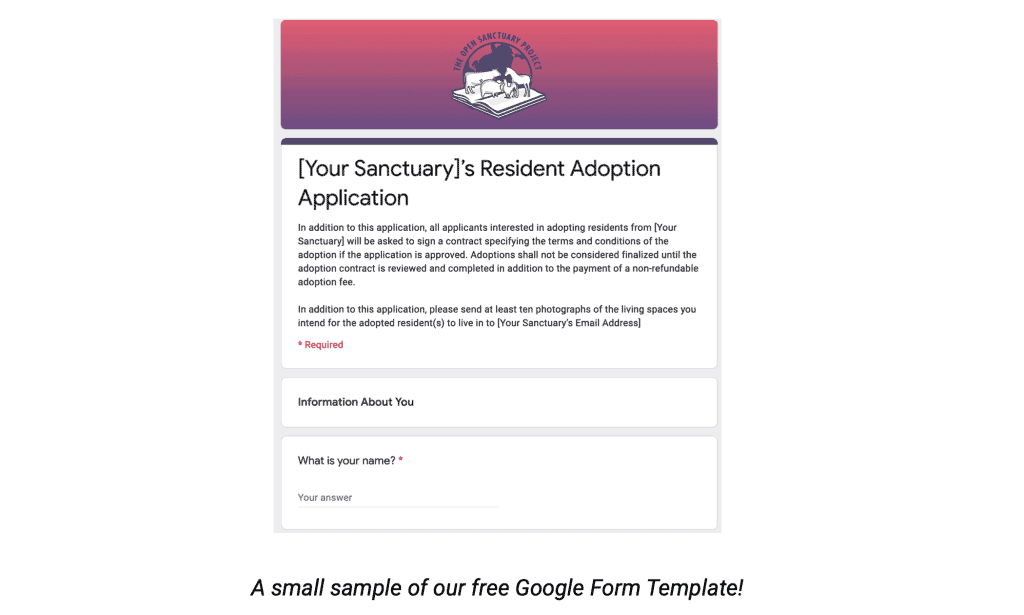
We Aren’t Your Lawyer!
The Open Sanctuary Project is not a law firm and this resource is not a substitute for the services of an attorney. Accordingly, you should not construe any of the information presented as legal advice that is suitable to meet your particular situation or needs. Please review our disclaimer if you haven’t yet.
The Open Sanctuary Project has developed a free downloadable template of a sanctuary resident adoption application, which you can download here! While the template may require modification to suit each sanctuary’s policies and philosophy, we believe it offers a good foundation of application questions to consider including in one’s adoption application. Also available is the application as an editable, private Google Form that sanctuaries can easily make their own and start using online!
The following elements are in our Adoption Application Template, along with a brief explanation of why they’re there (if not self-evident), as well as some upsides and downsides of including certain questions like these in adoption applications.
As a general rule, consider that a longer or more pointed adoption application may weed out potential adopters who would otherwise be great candidates, but may feel intimidated or put off by the intensity or scrutiny of the application. And a shorter or simpler application may result in more potential adopters who may require much more vetting before allowing an adoption to go through. You may want to navigate this by carefully vetting the potential adopter on the phone or in person with a list of questions prior to having them apply. Or you can do this kind of interview after a contract is completed, with follow up questions. Ultimately, deciding how detailed and lengthy to get in an adoption application, especially the first round, is up to a sanctuary’s Philosophy of Care.
Section 1: Information About You
“Address where adopted resident(s) will live (If different than above)”
This question can be valuable if the adopter wishes to keep the residents at a facility or on land that is not where they receive mail. It also provides a clear space to define where the adopted residents are expected to be should questions arise in the future. Again, keep in mind that adopting residents outside of your legal jurisdiction can have implications for your contract’s enforcement, should that become necessary.
“If others will be involved in the care of the adopted resident(s), please list them”
If other individuals are expected to be providing a significant amount of care to the adopted residents, it may be valuable to ask this question of potential adopters, though some sanctuaries may find this information to be ultimately extraneous since only one individual will likely be completing the application and by extension, the adoption contract.
“List two animal-related organizations that you are affiliated with, your role in them, and their contact information”
Some sanctuaries ask this question as a way of clarifying a potential adopter’s commitment to and experience with helping animals. A sanctuary may wish only to ask for one related organization, or, a sanctuary may wish to remove this section entirely, concluding that affiliation in any organization does not necessarily make one more capable of an adoption and providing lifelong care.
“With regards to animals, describe your current lifestyle”
This question can be valuable to help gauge a potential adopter’s values with regards to animals, especially farmed animalsA species or specific breed of animal that is raised by humans for the use of their bodies or what comes from their bodies.. As farmed animal sanctuariesAnimal sanctuaries that primarily care for rescued animals that were farmed by humans. take in individuals who are exploited for their flesh or what comes from them, this question can quickly help identify potential adopters who may pose a risk to adopted residents. However, some sanctuaries may not include this line of questioning, believing that there could potentially be good lifelong homes that do not necessarily follow certain lifestyles, or that it would be difficult to verify this information as it is, giving less value to the line of questioning.
“What is your annual household budget?”
Some sanctuaries wish to know this information in order to have a sense of what financial resources a potential adopter could have to budget for appropriate care of residents. Other sanctuaries find this question too sensitive or potentially invasive to include, especially early on in an adoption process.
“Can you commit to keeping an emergency veterinary services fund for the adopted resident(s)? If so, how much can you keep reserved for these services?”
Like an annual budget question, this question can either be valuable to help establish whether an individual has the resources and a practical perspective on the cost of veterinary care for adopted animals, though some may find it too restrictive or invasive of a question to ask in an adoption application, at least the initial part of the adoption process.
Employer Information
This question can be used to help verify information about a potential adopter’s income and stability, but many sanctuaries may not find this information valuable enough to include in terms of finding suitable adopters. It also may be considered too sensitive to share in an adoption application, though some sanctuaries may like to include questions like this to get a stronger picture of a potential adopter and their willingness to be open in order to find the best home possible for residents.
Section 2: Information About Your Property
“How long have you been on the property that the adopted resident(s) will live on?”
This question can be helpful for potentially determining an adopter’s financial and home life stability, and whether they have worked through necessary improvements or challenges of the land (as implied by more time being spent on the property). Of course, there is no guarantee that spending more time on a property makes one a more suitable adopter, or that less time spent on a property means that the property is not suitable for adopted residents to live on.
“Please describe the status of the property that the adopted resident(s) will live on”
Like the previous question, this question can help determine whether a potential adopter is more likely to be secure where they’re living, and whether they’ve cleared with a landlord or property manager that additional animals are allowed to live on the property- potentially preventing the challenge of an adopter needing to return a resident upon a landlord discovering this new living arrangement. Some sanctuaries may find this an unnecessary question, so long as the land is properly zoned for the residents the adopter wishes to adopt.
Number / Age Of Children Living On The Property
This question can help determine if certain residents would be suitable to live at certain properties, as those who may be more reactive to children may not be great fits in certain adoptive homes, especially if children will have access to the residents. A sanctuary may not wish to include this question if they do not plan on adopting out residents who they deem risky to spend time around children- and some sanctuaries might not ask it after concluding that one cannot know how any individual child will act around individual animals as it is.
“Have you confirmed with local ordinances that your property is zoned for the species and number of residents you wish to adopt?”
Because different residents will face different zoning restrictions in different regions, this can be a valuable question to ask, especially to get potential adopters thinking about zoning questions if they didn’t think about them before. This can help determine how serious and thoughtful a potential adopter is about providing lifelong care to a resident. It is always worth checking the zoning yourself as well, as zoning can change and adopters may not always be aware of changes. Checking in with the county and municipality in which the potential adopter resides can help you to be certain that their zoning allows for the residents that they propose to adopt.
“Describe the indoor and outdoor living spaces that the resident(s) will live on, including fencing”
This question can be valuable to help determine a potential adopter’s setup, and potentially more importantly, what they think is an appropriate living space for the residents they wish to adopt. Some sanctuaries may opt against asking this question, as they already require a home visit prior to approving the adoption and making living space improvement suggestions in person for an otherwise appropriate home.
“Describe what measures of predator protection you’ve taken or will take to protect the resident(s) you wish to adopt”
This question can be helpful for assessing how much a potential adopter has considered predators in their area, the risks to potential adopted residents, and their philosophy for managing these risks. Like the above question, some sanctuaries may decide to save this discussion for an in-person living space visit.
“What other animals live on your property? Will they be kept separate from the adopted resident(s)”
This question can be valuable for a number of reasons, including determining a potential adopter’s existing commitments, capability for providing care for residents, their bandwidth, and for determining whether they’ve considered how an adopted resident will safely fit into their life. Some sanctuaries may choose not to ask this question because simply knowing how many or how few animals are currently in someone’s life does not ultimately determine whether they’d be a suitable adopter, as having many well taken care of animals is just as possible as one or two poorly cared for animals.
Regardless of whether a sanctuary asks this question on an adoption application, it’s still prudent to eventually learn about the animals and species already a potential adopter’s life, because it will ultimately have substantial sway over whether any particular resident or residents to be adopted might be a good fit overall.
“Please send at least ten photographs of the living spaces you intend for the adopted resident(s) to live in to [Your Sanctuary’s Email Address]”
Some sanctuaries may decide to use this question as it provides quick contextualizing data for both an adopter’s potential living spaces and their ability to follow guidelines. Other sanctuaries may find this to be an unnecessary step, especially if they already plan on a site visit to help determine suitability.
Section 3: Adoption Specifics
“Why are you interested in adopting one or more residents from us?”
This question can be valuable for determining someone’s specific reasons for adoption, though some sanctuaries may prefer to reserve this question for a phone or in-person visit.
“How did you hear of [Your Sanctuary]? Have you volunteered or visited us?”
This question can help determine someone’s familiarity with your organization and values, though it may not be necessary if your sanctuary keeps detailed volunteer or visitor logs that can be quickly referenced.
“Can you share more detail about the resident(s) you’re looking to adopt? Do you have one or more specific individuals in mind to adopt?”
This question can help determine whether a potential adopter is looking for a specific individual to adopt, or a specific kind of resident to fit their lifestyle or spatial needs, or perhaps as a suitable companion to an existing resident of theirs. This question can also help weed out those who are looking for animals specifically to use them (such as those who ask for laying individuals or woolen ones).
“The adoption of some residents may require also adopting and providing lifelong care to one or more of their friends or relatives. Are you open to and prepared for this possibility?”
Because many species are happiest in pairs, herds, or flocks, some sanctuaries require that companions also be adopted out for the sake of a resident’s mental and emotional well-being. This question can help determine whether this is a possibility for this adopter, or whether they’d need to truly adopt just one individual, if that would be suitable for the individual being adopted. Some sanctuaries may not adopt out multiple residents at a time and would not need to ask this question.
“If you plan to adopt woolen residents, how do you plan to address their wool?”
Because woolen residents must have their wool managed, it can be valuable to ask this question to see how much a potential adopter is aware of this need, and what plans they have (if any) for the resulting fiber. For sanctuaries who do not plan to adopt out a woolen resident, this is not a particularly valuable question.
“If you plan to adopt egg-laying residents, how do you plan to address their egg-laying?”
Because egg-laying residents must have their eggs addressed one way or another, it can be valuable to ask this question to see what plans an adopter has (if any) for the eggs, or if they may be planning on implantation. For sanctuaries who do not plan to adopt out egg-laying residents, this is not a particularly valuable question.
“If you plan to adopt horses, how do you plan to address their need for exercise?”
Because equine residents often require exercise, it can be valuable to ask this question to see what plans an adopter has (if any) for this need, especially to see if they plan on riding said resident. For sanctuaries who do not plan to adopt out horse residents, this is not a particularly valuable question.
“How have you educated yourself on the proper care of the species you’re interested in adopting? What is your care experience background in these species?”
These questions can help clarify a potential adopter’s experience level with lifelong care for species, or their willingness to learn (and for those who would like to learn, we would recommend that any sanctuary wishing to provide information on proper lifelong care for species forward along our resources!)
“What is your philosophy on euthanasia as it pertains to nonhuman animals?”
This question can help demonstrate whether a potential adopter’s views align with your organization’s, especially when it comes to compassionate euthanasia, and the value of a resident’s comfort at all times. Some may choose not to ask this question as it can be quite sensitive and may be best saved for an in-person conversation further along in the adoption process.
“Name of veterinarian or clinic(s) you intend to use”
This question can help demonstrate that an adopter has thoughtfully considered the needs of potential adopted residents, and crucially, that they have access to or a relationship with a qualified veterinarian. Some organizations may even wish to consider asking for permission to call the adopter’s veterinarian to verify that they are a client, or for a reference. Other organizations may not include this question in an initial adoption application, saving it for a more detailed discussion further along in the process.
“Please list two personal references”
Like the “affiliation with animal organizations” question, this question can help an organization get to know a potential adopter better, and verify certain information from outside sources. Some may choose to have more or fewer references listed, or may omit this section entirely, finding that this information does not ultimately reflect one’s ability to provide lifelong care for an animal, and that references could technically be told to provide certain answers.
What To Do After Receiving An Encouraging Application
Sanctuaries take different approaches after receiving an application that seems promising. Some schedule multiple phone, then in-person visits to determine suitability. Others require that potential adopters come visit the resident or residents they wish to adopt. Others still may require that a potential adopter volunteer at the sanctuary to get a sense of their commitment or ability. Ultimately, each sanctuary must decide what process feels most right for balancing the need to evaluate an adopter’s suitability with the risk of losing good adopters to adoption processes that may be too intense to commit to. For some sanctuaries, this evaluation may be worth the loss of many potential adopters, for others, they may prefer to give adopters a greater benefit of the doubt that they will likely be suitable based on less strict criteria.
However a sanctuary comes to the conclusion to move forward with an adoption, we do recommend that they make use of an adoption contract!
Breaking Down Elements Of An Adoption Contract
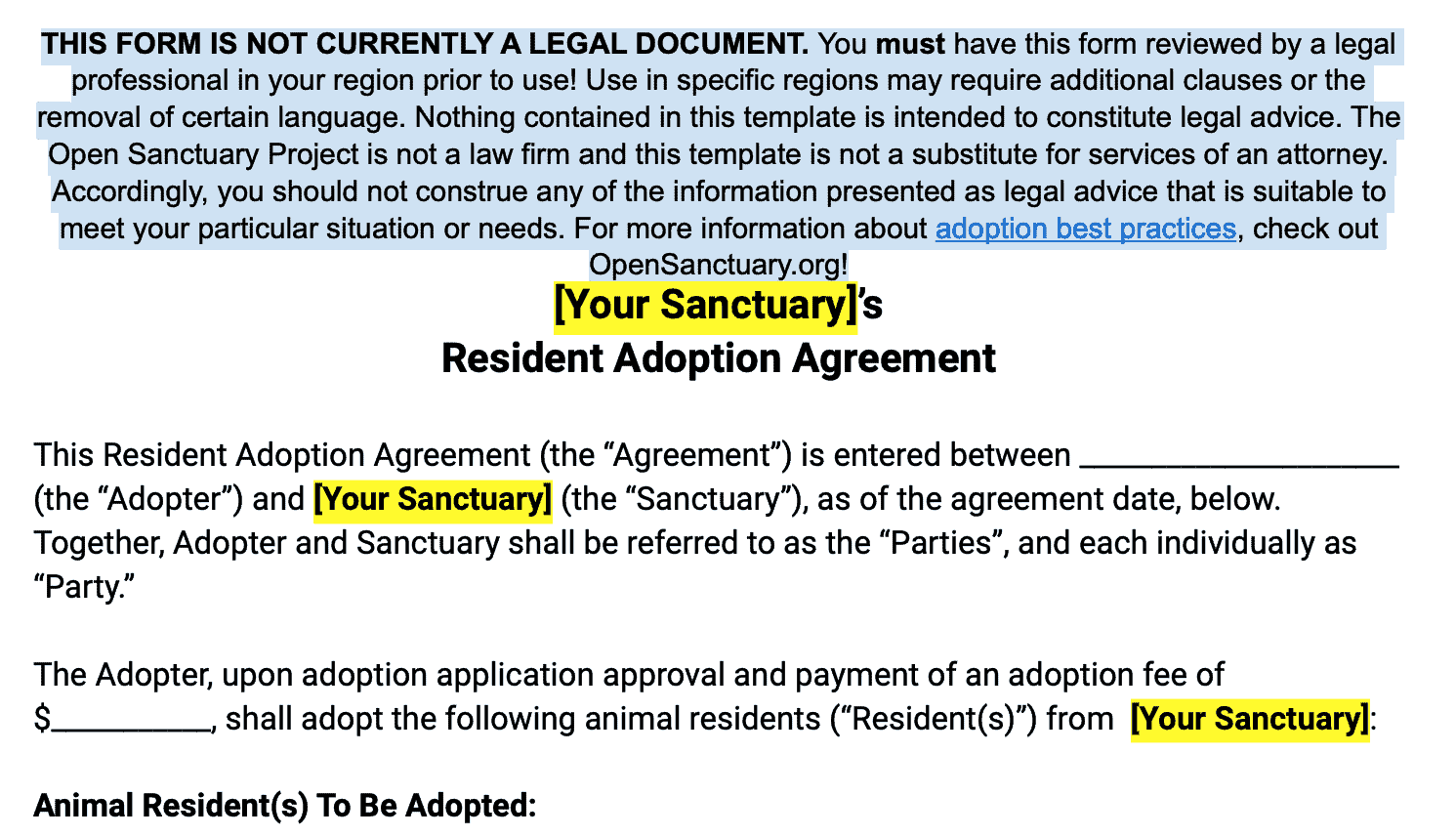
Like the adoption application above, The Open Sanctuary Project has developed a free downloadable template of a sanctuary resident adoption contract, which you can download here! While the template will require modification to suit each sanctuary’s policies and philosophy (and will require legal review and modification by a qualified legal professional in the sanctuary’s region in order to become legally acceptable- please review our legal disclaimer), we believe it is a solid foundation which sanctuaries can use to create suitable adoption contracts with many common provisions and terms laid out clearly.
The following elements are in our Adoption Contract template, along with a brief explanation. Should a sanctuary choose to create their own adoption contract from scratch, they may consider including these common elements:
Contract Title – (“[Your Sanctuary]’s Resident Adoption Agreement”)
This is a simple way of identifying the document and its purpose. All contracts should have clear titles!
Opening Clause
This Resident Adoption Agreement (the “Agreement”) is entered between ______________________ (the “Adopter”) and [Your Sanctuary] (the “Sanctuary”), as of the agreement date, below. Together, Adopter and Sanctuary shall be referred to as the “Parties”, and each individually as “Party.”
The Adopter, upon adoption application approval and payment of an adoption fee of $___________, shall adopt the following animal residents (“Resident(s)”) from [Your Sanctuary]:
This section clearly identifies the parties and how they will be referred to in the contract. Additionally, this section includes a section for an adoption fee, which some sanctuaries may choose to forgo in certain adoptions or for all adoptions.
Animal Resident(s) To Be Adopted
This section provides space to clearly identify the animal residents who are to be covered by the terms and conditions of this contract. Sanctuaries may choose to modify the template with fewer or greater spaces for animals to be identified, but we believe they should keep the sections for both species and identification numbers for each adopted resident, to ensure that they are easily identifiable to those reading the document in the future. There is also a checkbox to append an additional page, should a sanctuary wish to occasionally adopt out a greater number of residents at once.
Terms And Conditions Of This Adoption
This section covers the bulk of the contract- it covers everything that the adopter agrees to as a condition of adoption. Sanctuaries should carefully review the terms suggested and then decide whether they wish to modify any of the terms, redact terms, or add additional ones. We believe the terms included cover most of the considerations that shelters and sanctuaries wish to cover in a comprehensive adoption contract, but each sanctuary must decide what terms are right for their adoption program and tolerance for risk. Certain terms and condition (or certain verbiage of certain terms and conditions) may not be legally acceptable in certain regions of the world, which is why it’s critical for a qualified legal professional to review the document prior to its use.
1. Adoption Requirements
This section covers the basics of providing acceptable lifelong care for residents in an adopting home, including not causing harm of any kind, adhering to quarantine upon arrival for resident safety, providing appropriate conditions, companionship, and documentation to ensure good healthcare. A sanctuary may decide that some of these requirements are too difficult to achieve, others many decide for stricter requirements.
2. The Health & Behavior Of The Residents
This section helps protect the sanctuary by acknowledging that the health and behavior of residents cannot be guaranteed given their backgrounds.
3. Release Of Liability
This section is to ensure that an adopter knows that if an adopted resident causes harmThe infliction of mental, emotional, and/or physical pain, suffering, or loss. Harm can occur intentionally or unintentionally and directly or indirectly. Someone can intentionally cause direct harm (e.g., punitively cutting a sheep's skin while shearing them) or unintentionally cause direct harm (e.g., your hand slips while shearing a sheep, causing an accidental wound on their skin). Likewise, someone can intentionally cause indirect harm (e.g., selling socks made from a sanctuary resident's wool and encouraging folks who purchase them to buy more products made from the wool of farmed sheep) or unintentionally cause indirect harm (e.g., selling socks made from a sanctuary resident's wool, which inadvertently perpetuates the idea that it is ok to commodify sheep for their wool)., the sanctuary should not be held responsible.
4. A Financial Responsibility To The Resident
This section helps reinforce the agreement that an adopter must provide financial resources to properly care for the adopted residents, and that this is not the sanctuary’s responsibility. Sanctuaries may choose to modify this if they do wish to provide some sort of financial assistance to adopting parties for resident care under certain circumstances.
5. Tenancy & Family Members
This section is to ensure that the adopter is being responsible and that a landlord won’t unexpectedly force the adopter to remove the adopted residents from the property, and that all family members are also informed of the expectations associated with the adoption.
6. The Adoption Fee
This section quickly explains the purpose of the adoption fee, and explains that it is non-refundable. Sanctuaries who do not charge fees may wish to omit this section, or sanctuaries who do wish to make fees refundable may wish to change the verbiage of this section.
7. Prohibition Of Transfer
This section prevents the adopter from giving the adopted residents to other people or organizations, with the exception of assigning the adopted residents in a will to a qualified successor. Some sanctuaries may not wish to include this stipulation and require that the adopted residents be returned to the sanctuary instead.
8. Notification Of Loss Of The Resident(s)
This section requires that the adopter keep the sanctuary up to date on the status of the adopted residents, which can be important in case they’ve adopted many residents and they are acting in an irresponsible manner. If they adhere to this term, the sanctuary can use notifications of loss as a reason to check in and ensure proper care is being provided.
9. Relinquishing The Resident(s)
This provides a defined way for the adopter to get help from the sanctuary instead of simply giving up a resident to another person or organization if they are having issues.
10. Returning The Resident(s)
Building off of the above section, this section allows the adopter to return adopted residents to the sanctuary if necessary (at the cost of the adopter). Some sanctuaries may wish to go into more detail in this section, or prohibit returns to the sanctuary, or potentially offer to shoulder some of the cost if residents need to return to the sanctuary.
11. Wellness Reporting & Facility Visits from [Your Sanctuary]
This section provides some ways for a sanctuary to ensure that adopted residents are receiving proper care. Sanctuaries may wish to loosen or strengthen these terms and conditions, depending on their staff ability and capacity.
12. [Your Sanctuary]’s Right To Immediate Possession Of The Resident(s)
This section gives a way for a sanctuary to take adopted residents home for practically any reason, and with no recourse. Sanctuaries should very carefully review this section, as it might be either not enforceable in their area, or could actually have significant negative implications legally for the organization – some argue that this provision opens up a sanctuary to liability since it may be arguable that they are not relinquishing custody of residents under these terms, so anything that the residents do, or anything that happens to them, may be the sanctuary’s responsibility. For this reason, a sanctuary must review this section with a legal professional and their executive team.
13. A Perpetual Media License
This section (which may require a verbiage update in certain regions) allows the sanctuary to keep using photos of the adopted residents as well as their story to fund-raise and educate in the future. This can be very helpful to also promote a sanctuary’s adoption program!
14-21 : Legal Sections
These sections are common parts of contract law, especially in The United States. They should be carefully reviewed by a legal professional!
Signing Section
This section is very important, as contracts are not contracts without agreements indicated by signatures! Any adoption contract should have this section, or something very similar to it.
The Case Against An Adoption Program
Many sanctuaries see themselves as the permanent forever home of all residents coming under their care, and therefore do not offer adoption programs. There are a number of arguments for this decision, including:
- A sanctuary may not wish to further stress out a resident who has likely been through a great deal of trauma in their life with yet another move of residence, especially given the risk that they may have to move once again if the adoption does not work out
- A sanctuary may not wish to separate a resident from others in their herd who they may have gotten to know and appreciate in their day to day lives
- It takes a great deal of resources to create a responsible adoption program, including personnel who are willing to vet potential adopting parties and a care staff willing to travel to assess how well the adoption is going, as well as the potential legal headaches that could arise out of an adoption-related dispute
- Tragically, there have been many public cases where well-meaning sanctuaries and rescues have adopted out residents only for the residents to be exploited or killed by the adoptive party. A sanctuary may find it simply too risky to trust a private party to give the same level of love and care to a beloved resident
Consider An “Adoption” Sponsorship Program
If you’re looking for a way to get people involved with residents who they love and wish they could support on a deeper level, but you aren’t necessarily interested in ever adopting out any residents, consider creating an “Adopt-A-Resident” sponsorship program! Many sanctuaries have found success giving supporters a way to financially support certain residents in this way. These supporters could be given special updates or (depending on your sanctuary’s Philosophy of Care) special guided visitation with residents who they’re generously supporting. Some sanctuaries clarify that this money goes into a general fund to care for other residents of the same species or sanctuary-wide as well, whereas others strictly implement this program to allocate the donated funds only to the residents being sponsored. Some sanctuaries only implement a sponsorship program when a resident requires extra financial support due to health challenges or special care needs. However you feel comfortable with its implementation, sponsorships are a tried and true method for providing much-needed resources and making your supporters feel more deeply invested in the lives and well-being of your residents!
SOURCES:
